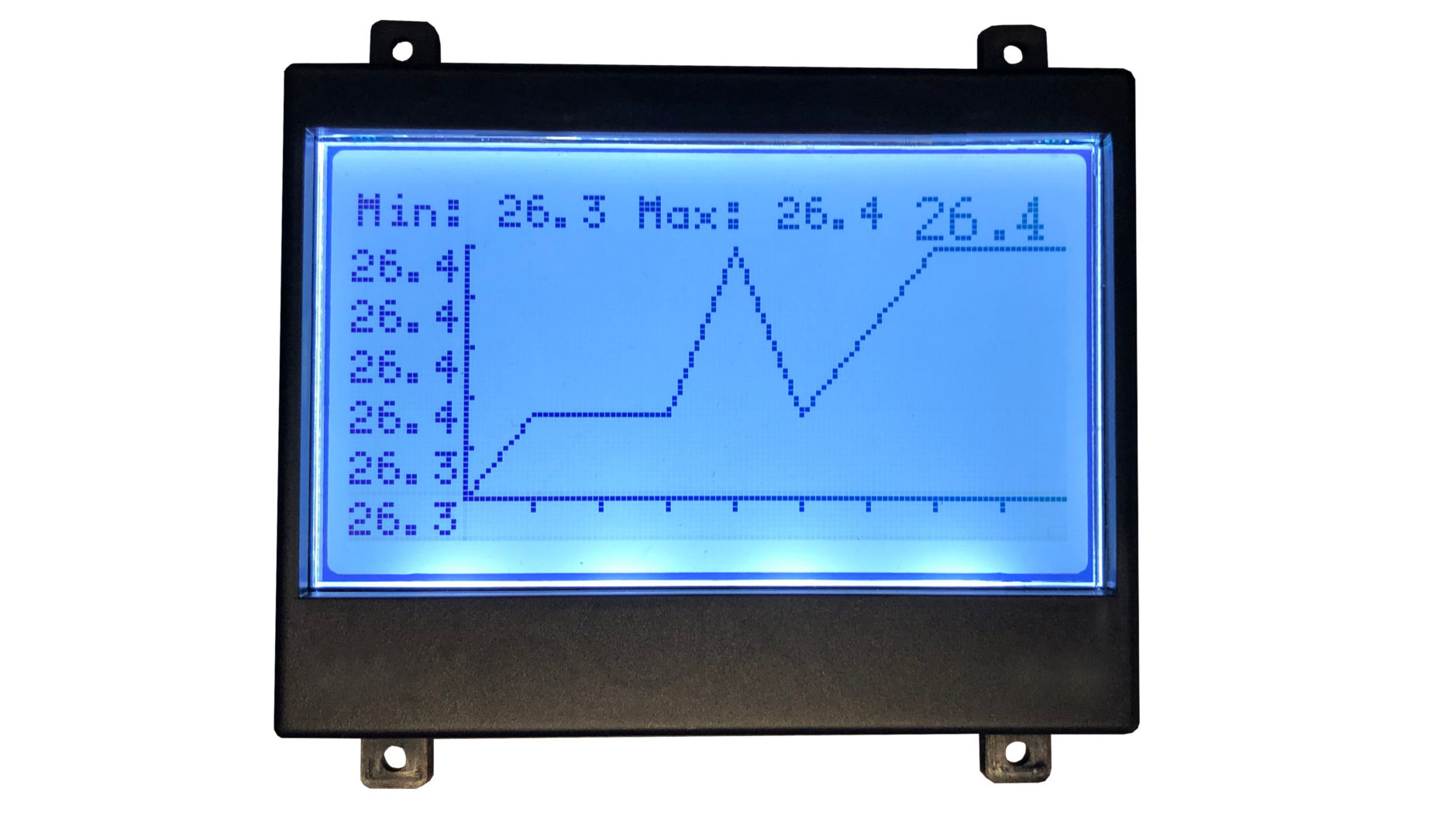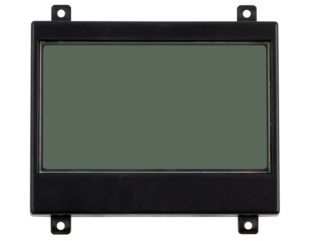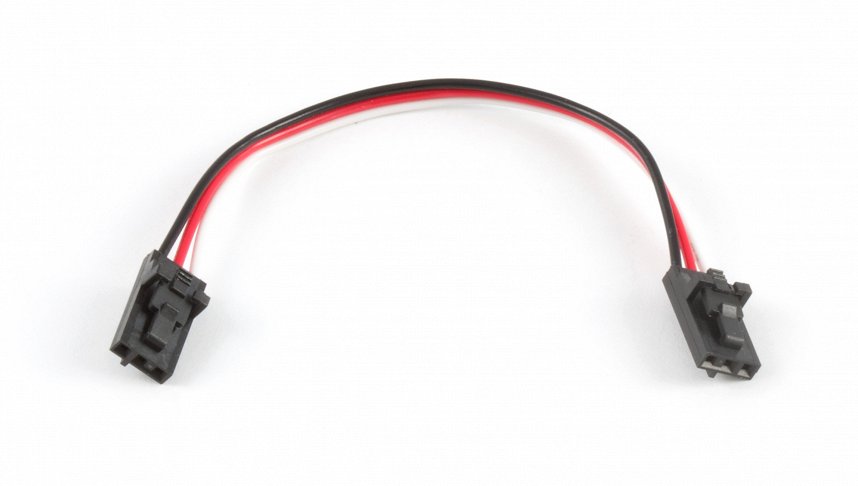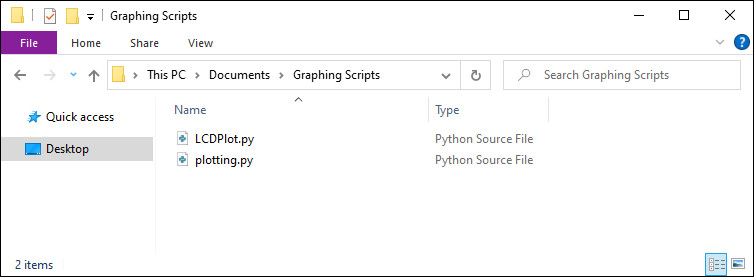Setup
Before getting started, make sure you have the following parts.
VINT Hub
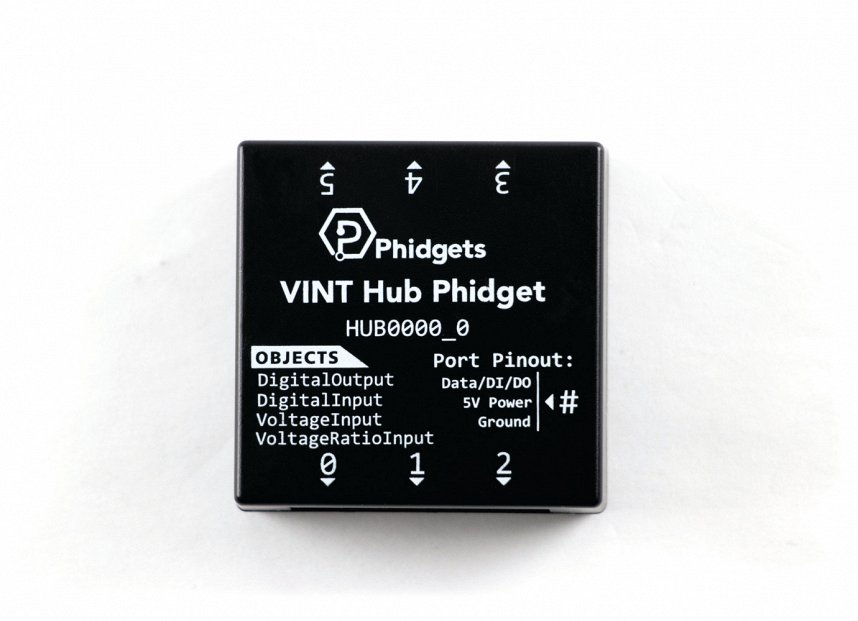
Graphing Library (Java)
Copy the code below into a new Java file called LCDPlot.java
Not your programming language? Set your preferences so we can display relevant code examples
import java.io.FileWriter;
import java.text.DecimalFormat;
import java.time.LocalDateTime;
import java.time.format.DateTimeFormatter;
import java.util.ArrayList;
import java.util.Collections;
import com.phidget22.LCD;
import com.phidget22.LCDFont;
public class LCDPlot {
private static ArrayList data = new ArrayList();
private ArrayList pixelData = new ArrayList();
private DecimalFormat df = new DecimalFormat("0.0");
private static int numPoints;
private double maxTemp = 0;
private double minTemp = 0;
private LCD lcd;
private boolean recordData;
private Record writeData;
private int LCD_WIDTH = 127;
private int Graph_WIDTH = 107;
private int Graph_HEIGHT = 45;
public LCDPlot() {
}
;
// Constructor that records the data passed by user
public LCDPlot(int dataPoints, boolean recordData) throws Exception {
numPoints = dataPoints;
lcd = new LCD();
lcd.open(1000);
lcd.setBacklight(0.5); // Enable backlight
this.recordData = recordData;
if (recordData) {
writeData = new Record();
}
}
// Main function that runs all the other functions
public void start() throws Exception {
if (recordData) {
writeData.writeValue();
}
display();
yScaling();
xScaling();
graph();
}
// Gets temp from temperature sensor and records in array
public void addDataPoint(double num) throws Exception {
// Limits array size to the number of points displayed on the screen
if (data.size() >= numPoints) {
data.remove(0);
}
data.add(num);
start();
}
// Displays elements of graph
private void display() throws Exception {
// This initializes the graph axis
lcd.drawLine(20, 11, 20, 56);
lcd.drawLine(20, 56, 127, 56);
maxTemp = Collections.max(data);
minTemp = Collections.min(data);
// Writes Max, Min and Current Temp
lcd.writeText(LCDFont.DIMENSIONS_5X8, 1, 1, "Min: " + String.valueOf(df.format(minTemp)));
lcd.writeText(LCDFont.DIMENSIONS_5X8, 51, 1, "Max: " + String.valueOf(df.format(maxTemp)));
lcd.writeText(LCDFont.DIMENSIONS_6X12, 101, 1, String.valueOf(df.format(data.get(data.size() - 1))));
}
// Auto scales y-axis
private void yScaling() throws Exception {
Double temp = Collections.max(data);
Double scale = ((maxTemp - minTemp) / 5);
// Draws ticks and numbers | Starts on pixel 11 and moves down 9 pixels at a
// time. At each increment, a small visible line is drawn to indicate the
// location as well as a numeric value is printed out on the screen.
for (int i = 11; i <= 56; i += 9) {
lcd.drawLine(20, i, 21, i);
lcd.writeText(LCDFont.DIMENSIONS_5X8, 0, i, Double.toString(Double.valueOf(df.format(temp))));
temp -= scale;
}
}
// Auto scales x-axis
private void xScaling() throws Exception {
// Draws ticks on x-axis |The graph starts at pixel 20, and draws a vertical
// tick of width 2 across the x-axis for each data point
int scale = Math.round(Graph_WIDTH / (numPoints - 1));
for (int i = 20 + scale; i < LCD_WIDTH; i += scale) {
lcd.drawLine(i, 56, i, 58);
}
}
// Draws the graph
private void graph() throws Exception {
double range = maxTemp - minTemp;
int scale = Math.round(Graph_WIDTH / (numPoints - 1));
// Changes the pixel location of the data based on min and max data points |
// Math: Let x be the pixel location of the data point. x/Graph_Height in pixels
// = (data point - min temp)/temp range.
// Solving for x will result in a ratio where the pixel location simulates the
// distribution of the temperature
for (int i = 0; i < data.size(); i++) {
double pixel = 56 - (data.get(i) - minTemp) / range * Graph_HEIGHT;
pixelData.add((int) Math.round(pixel));
}
// Temp 2 gives the pixel for the first time data point
int temp2 = 20;
// Graphs data | The LCD will draw a line between the pixel of the previous data
// point and the current data point
for (int i = 0; i < data.size(); i++) {
if (i > 0) {
lcd.drawLine(temp2 - scale, pixelData.get(i - 1), temp2, pixelData.get(i));
}
temp2 += scale;
}
pixelData.clear();
lcd.flush();
// Clears the space of the graph essential refreshing the screen every time a
// new data point is added
lcd.drawRect(21, 11, LCD_WIDTH, 55, true, true);
}
public void closeDevices() {
try {
// Close LCD so it isnt left on at the end of the program
lcd.close();
} catch (Exception e) {
// This is a better way of handeling exceptions vs throwing them
System.out.printf("Error when trying to close LCD:\n%s", e);
}
}
// Records the temp into a file
class Record extends LCDPlot {
String name;
FileWriter outfile;
int count = 0;
int counter = 0;
public Record() throws Exception {
DateTimeFormatter dtf = DateTimeFormatter.ofPattern("yyyy/MM/dd HH:mm:ss");
LocalDateTime now = LocalDateTime.now();
name = dtf.format(now);
// Can't title files with "/" or ":" so they are replaced by "_" and "."
name = name.replace("/", "_").replace(":", ".");
}
public void writeValue() throws Exception {
// Creates a file writer to the csv file
outfile = new FileWriter(name + ".csv", true);
// If it is the first data point, then it titles the columns in excel file
if (count == 0) {
outfile.write("Data Points, Temperature \n");
}
// Count keeps track of what data point we are on | If count exceeds the total
// numPoints (i.e. the number of points present in the data array) then we
// control counter (the index on the most recent data point in the array) to be the last element
// in the array
if (count >= numPoints) {
this.counter = numPoints - 1;
}
// Writes data point number and data value to excel file
String num = Double.toString(data.get(this.counter));
outfile.write(Integer.toString(count) + "," + num + "\n");
count++;
this.counter++;
outfile.close();
}
}
}
package plotting;
import java.io.FileWriter;
import java.text.DecimalFormat;
import java.time.LocalDateTime;
import java.time.format.DateTimeFormatter;
import java.util.ArrayList;
import java.util.Collections;
import com.phidget22.LCD;
import com.phidget22.LCDFont;
public class LCDPlot {
private static ArrayList data = new ArrayList();
private ArrayList pixelData = new ArrayList();
private DecimalFormat df = new DecimalFormat("0.0");
private static int numPoints;
private double maxTemp = 0;
private double minTemp = 0;
private LCD lcd;
private boolean recordData;
private Record writeData;
private int LCD_WIDTH = 127;
private int Graph_WIDTH = 107;
private int Graph_HEIGHT = 45;
public LCDPlot() {
}
;
// Constructor that records the data passed by user
public LCDPlot(int dataPoints, boolean recordData) throws Exception {
numPoints = dataPoints;
lcd = new LCD();
lcd.open(1000);
lcd.setBacklight(0.5); // Enable backlight
this.recordData = recordData;
if (recordData) {
writeData = new Record();
}
}
// Main function that runs all the other functions
public void start() throws Exception {
if (recordData) {
writeData.writeValue();
}
display();
yScaling();
xScaling();
graph();
}
// Gets temp from temperature sensor and records in array
public void addDataPoint(double num) throws Exception {
// Limits array size to the number of points displayed on the screen
if (data.size() >= numPoints) {
data.remove(0);
}
data.add(num);
start();
}
// Displays elements of graph
private void display() throws Exception {
// This initializes the graph axis
lcd.drawLine(20, 11, 20, 56);
lcd.drawLine(20, 56, 127, 56);
maxTemp = Collections.max(data);
minTemp = Collections.min(data);
// Writes Max, Min and Current Temp
lcd.writeText(LCDFont.DIMENSIONS_5X8, 1, 1, "Min: " + String.valueOf(df.format(minTemp)));
lcd.writeText(LCDFont.DIMENSIONS_5X8, 51, 1, "Max: " + String.valueOf(df.format(maxTemp)));
lcd.writeText(LCDFont.DIMENSIONS_6X12, 101, 1, String.valueOf(df.format(data.get(data.size() - 1))));
}
// Auto scales y-axis
private void yScaling() throws Exception {
Double temp = Collections.max(data);
Double scale = ((maxTemp - minTemp) / 5);
// Draws ticks and numbers | Starts on pixel 11 and moves down 9 pixels at a
// time. At each increment, a small visible line is drawn to indicate the
// location as well as a numeric value is printed out on the screen.
for (int i = 11; i <= 56; i += 9) {
lcd.drawLine(20, i, 21, i);
lcd.writeText(LCDFont.DIMENSIONS_5X8, 0, i, Double.toString(Double.valueOf(df.format(temp))));
temp -= scale;
}
}
// Auto scales x-axis
private void xScaling() throws Exception {
// Draws ticks on x-axis |The graph starts at pixel 20, and draws a vertical
// tick of width 2 across the x-axis for each data point
int scale = Math.round(Graph_WIDTH / (numPoints - 1));
for (int i = 20 + scale; i < LCD_WIDTH; i += scale) {
lcd.drawLine(i, 56, i, 58);
}
}
// Draws the graph
private void graph() throws Exception {
double range = maxTemp - minTemp;
int scale = Math.round(Graph_WIDTH / (numPoints - 1));
// Changes the pixel location of the data based on min and max data points |
// Math: Let x be the pixel location of the data point. x/Graph_Height in pixels
// = (data point - min temp)/temp range.
// Solving for x will result in a ratio where the pixel location simulates the
// distribution of the temperature
for (int i = 0; i < data.size(); i++) {
double pixel = 56 - (data.get(i) - minTemp) / range * Graph_HEIGHT;
pixelData.add((int) Math.round(pixel));
}
// Temp 2 gives the pixel for the first time data point
int temp2 = 20;
// Graphs data | The LCD will draw a line between the pixel of the previous data
// point and the current data point
for (int i = 0; i < data.size(); i++) {
if (i > 0) {
lcd.drawLine(temp2 - scale, pixelData.get(i - 1), temp2, pixelData.get(i));
}
temp2 += scale;
}
pixelData.clear();
lcd.flush();
// Clears the space of the graph essential refreshing the screen every time a
// new data point is added
lcd.drawRect(21, 11, LCD_WIDTH, 55, true, true);
}
public void closeDevices() {
try {
// Close LCD so it isnt left on at the end of the program
lcd.close();
} catch (Exception e) {
// This is a better way of handeling exceptions vs throwing them
System.out.printf("Error when trying to close LCD:\n%s", e);
}
}
// Records the temp into a file
class Record extends LCDPlot {
String name;
FileWriter outfile;
int count = 0;
int counter = 0;
public Record() throws Exception {
DateTimeFormatter dtf = DateTimeFormatter.ofPattern("yyyy/MM/dd HH:mm:ss");
LocalDateTime now = LocalDateTime.now();
name = dtf.format(now);
// Can't title files with "/" or ":" so they are replaced by "_" and "."
name = name.replace("/", "_").replace(":", ".");
}
public void writeValue() throws Exception {
// Creates a file writer to the csv file
outfile = new FileWriter(name + ".csv", true);
// If it is the first data point, then it titles the columns in excel file
if (count == 0) {
outfile.write("Data Points, Temperature \n");
}
// Count keeps track of what data point we are on | If count exceeds the total
// numPoints (i.e. the number of points present in the data array) then we
// control counter (the index on the most recent data point in the array) to be the last element
// in the array
if (count >= numPoints) {
this.counter = numPoints - 1;
}
// Writes data point number and data value to excel file
String num = Double.toString(data.get(this.counter));
outfile.write(Integer.toString(count) + "," + num + "\n");
count++;
this.counter++;
outfile.close();
}
}
}
Code not available for Processing.
Graphing Library (Python)
Copy the code below into a new Python file called LCDPlot.py
Not your programming language? Set your preferences so we can display relevant code examples
from Phidget22.Devices.LCD import *
from datetime import datetime
class LCDPlot:
name = ""
counting = 0
count = 0
data = []
pixel_data = []
num_points = 0
max_temp = 0
min_temp = 0
lcd = LCD()
record = True
LCD_WIDTH = 127
Graph_WIDTH = 107
Graph_HEIGHT = 45
# Constructor that self.self.records the self.self.data passed by user
def __init__(self, dataPoints, record_data):
self.lcd.openWaitForAttachment(1000)
self.lcd.setBacklight(0.5)
self.num_points = dataPoints
self.record = record_data
# Initializes the name of the file with date and time
# Can't title files with "/" or ":" so they are replaced by "_" and "."
if self.record:
# Get current time when starting program
# Used to name the csv file to which the data will be written to
self.name = datetime.now().strftime("%m_%d_%Y %H.%M.%S")
# Main function that runs all the other functions
def start(self):
if self.record:
self.write_file()
self.display()
self.y_scaling()
self.x_scaling()
self.graph()
# Gets temp from temperature sensor and records in array
def add_data_point(self, num):
# Limits array size to the number of points displayed on the screen
if len(self.data) >= self.num_points:
self.data.pop(0)
self.data.append(num)
self.start()
# Displays elements of graph
def display(self):
# This initializes the graph axis
self.lcd.drawLine(20, 11, 20, 56)
self.lcd.drawLine(20, 56, 127, 56)
self.max_temp = max(self.data)
self.min_temp = min(self.data)
# Writes Max, Min and Current Temp
self.lcd.writeText(LCDFont.FONT_5x8, 1, 1, "Min: " + str(round(self.min_temp, 1)))
self.lcd.writeText(LCDFont.FONT_5x8, 51, 1, "Max: " + str(round(self.max_temp, 1)))
self.lcd.writeText(LCDFont.FONT_6x12, 101, 1, str(round(self.data[len(self.data) - 1], 1)))
# Auto scales x-axis
def x_scaling(self):
# Draws ticks on x-axis |The graph starts at pixel 20, and draws a vertical
# tick of width 2 across the x-axis for each data point
scale = round(self.Graph_WIDTH / (self.num_points - 1))
i = 20 + scale
while i < self.LCD_WIDTH:
self.lcd.drawLine(i, 56, i, 58)
i += scale
# Auto scales y-axis
def y_scaling(self):
temp = max(self.data)
scale = ((self.max_temp - self.min_temp) / 5)
# Draws ticks and numbers | Starts on pixel 11 and moves down 9 pixels at a
# time. At each increment, a small visible line is drawn to indicate the
# location as well as a numeric value is printed out on the screen.
i = 11
while i <= 56:
self.lcd.drawLine(20, i, 21, i)
self.lcd.writeText(LCDFont.FONT_5x8, 0, i, str(round(temp, 1)))
temp -= scale
i += 9
# Draws the graph
def graph(self):
size = self.max_temp - self.min_temp
scale = round(self.Graph_WIDTH / (self.num_points - 1))
# Ensures that when there is only 1 data point the scale is not 0. | In this case, an arbitrary value for
# the scale is set so the the pixel location formula will not divide by zero. This is auto adjusted
# with more data points.
if size == 0:
size = 2
# Changes the pixel location of the data based on min and max data points |
# Math: Let x be the pixel location of the data point. x/Graph_Height in pixels
# = (data point - min temp)/temp range.
# Solving for x will result in a ratio where the pixel location simulates the
# distribution of the temperature
for i in range(len(self.data)):
pixel = 56 - (self.data[i] - self.min_temp) / size * self.Graph_HEIGHT
self.pixel_data.append(round(pixel))
# Temp 2 gives the pixel for the first time data point
temp2 = 20
# Graphs data | The LCD will draw a line between the pixel of the previous data
# point and the current data point
for i in range(len(self.data)):
if i > 0:
self.lcd.drawLine(temp2 - scale, self.pixel_data[i - 1], temp2, self.pixel_data[i])
temp2 += scale
self.pixel_data.clear()
self.lcd.flush()
# Clears the space of the graph essential refreshing the screen every time a
# new data point is added
self.lcd.drawRect(21, 11, self.LCD_WIDTH, 55, True, True)
# Records the temp into a file
def write_file(self):
# Creates a file writer to the csv file
file = open(self.name + ".csv", "a")
# If it is the first data point, then it titles the columns in excel file
if self.count == 0:
file.write("Data points" + "," + "Temperature \n")
# Count keeps track of what data point we are on | If count exceeds the total
# numPoints (i.e. the number of points present in the data array) then we
# control counter (the index on the most recent data point in the array) to be the last element
# in the array
if self.counting >= self.num_points:
self.counting = self.num_points - 1
# Writes data point number and data value to excel file
file.write(str(self.count) + "," + str(self.data[self.counting]) + "\n")
self.count += 1
self.counting += 1
file.close()
def close_objects(self):
self.lcd.close()
Graphing Library (C#)
Copy the code below into a new C# file called LCDPlot.cs
Not your programming language? Set your preferences so we can display relevant code examples
using System;
using System.Collections.Generic;
using System.IO;
using System.Linq;
using Phidget22;
namespace Plotting
{
class LCDPlot
{
public static List data = new List();
static List pixelData = new List();
public static int numPoints;
double maxTemp;
double minTemp;
LCD lcd;
Boolean recordData;
Record writeData;
int LCD_WIDTH = 127;
int Graph_WIDTH = 107;
int Graph_HEIGHT = 45;
public LCDPlot()
{
}
// Constructor that recrods data passed by user
public LCDPlot(int dataPoints, Boolean recordData)
{
numPoints = dataPoints;
lcd = new LCD();
lcd.Open(1000);
lcd.setBacklight(0.5);
this.recordData = recordData;
if (recordData)
writeData = new Record();
}
// Main function that runs all other functions
public void start()
{
if (recordData)
writeData.writeData();
Display();
XScaling();
YScaling();
Graph();
}
// Gets temp from temp sensor
public void addDataPoint(double num)
{
// Limits array size to the number of points displayed on the screen
if (data.Count() >= numPoints)
data.RemoveAt(0);
data.Add(num);
start();
}
//Displays elements of graph
private void Display()
{
// This initializes the graph axis
lcd.DrawLine(20, 11, 20, 56);
lcd.DrawLine(20, 56, LCD_WIDTH, 56);
maxTemp = data.Max();
minTemp = data.Min();
// Writes Max, Min and Current Temp
lcd.WriteText(LCDFont.Dimensions_5x8, 1, 1, "Min: " + minTemp.ToString("0.0"));
lcd.WriteText(LCDFont.Dimensions_5x8, 51, 1, "Max: " + maxTemp.ToString("0.0"));
lcd.WriteText(LCDFont.Dimensions_6x12, 101, 1, data[data.Count - 1].ToString("0.0"));
}
// Scales x-axis
private void XScaling()
{
double temp = Graph_WIDTH / (numPoints - 1);
int scale = (int)Math.Round(temp);
// Draws ticks on x-axis |The graph starts at pixel 20, and draws a vertical
// tick of width 2 across the x-axis for each data point
for (int i = 20 + scale; i 0)
lcd.DrawLine(temp2 - scale, pixelData[i - 1], temp2, pixelData[i]);
temp2 += scale;
}
pixelData.Clear();
lcd.Flush();
// Clears the space of the graph essential refreshing the screen every time a
// new data point is added
lcd.DrawRectangle(21, 11, LCD_WIDTH, 55, true, true);
}
}
// Records temp into a file
class Record : LCDPlot{
String name;
int count = 0;
int counter = 0;
public Record()
{
name = DateTime.Now.ToString();
// Can't title files with "/" or ":" so they are replaced by "_" and "."
name = name.Replace("/", "_").Replace(":", ".");
}
public void writeData()
{
// Creates a file writer to the csv file
StreamWriter sw = new StreamWriter(@name + ".csv", true);
// If it is the first data point, then it titles the columns in excel file
if (count == 0)
sw.WriteLine("data points, temperature");
// Count keeps track of what data point we are on | If count exceeds the total
// numPoints (i.e. the number of points present in the data array) then we
// control counter (the index on the most recent data point in the array) to be the last element
// in the array
if (count >= numPoints)
counter = numPoints - 1;
// Writes data point number and data value to excel file
sw.WriteLine(count.ToString() + "," + data[counter].ToString());
count++;
counter++;
sw.Close();
}
}
}
Write Code (Swift)
Code not available for Swift. Please set your preferences and select a new language.
Use the Graphing Library (Java)
Create a new Java project called Plotting and copy the code below into your project. If you need a reminder of how to do this, revisit the Getting Started Course.
Not your programming language? Set your preferences so we can display relevant code examples
//Add Phidgets Library
import com.phidget22.*;
public class Plotting {
public static void main(String[] args) throws Exception {
//Create
TemperatureSensor temperatureSensor = new TemperatureSensor();
//Open
temperatureSensor.open(1000);
//Create LCDPlot object
//First argument refers to the number of data points displayed on the graph
//Second argument indicates whether or not to store data to a file
LCDPlot graph = new LCDPlot(10, true);
//Use your Phidgets
while (true) {
graph.addDataPoint(temperatureSensor.getTemperature());
Thread.sleep(temperatureSensor.getDataInterval());
}
}
}
package plotting;
//Add Phidgets Library
import com.phidget22.*;
public class Plotting {
public static void main(String[] args) throws Exception {
//Create
TemperatureSensor temperatureSensor = new TemperatureSensor();
//Open
temperatureSensor.open(1000);
//Create LCDPlot object
//First argument refers to the number of data points displayed on the graph
//Second argument indicates whether or not to store data to a file
LCDPlot graph = new LCDPlot(10, true);
//Use your Phidgets
while (true) {
graph.addDataPoint(temperatureSensor.getTemperature());
Thread.sleep(temperatureSensor.getDataInterval());
}
}
}
Code not available for Processing.
Drag LCDPlot.java into your new project.
Use the Graphing Library (Python)
Copy the code below into a new Python script called plotting.py Not your programming language? Set your preferences so we can display relevant code examples
#Add Phidgets Library
from Phidget22.Devices.TemperatureSensor import *
#Required for LCD plotting
from LCDPlot import LCDPlot
#Required for sleep statement
import time
#Create
temperatureSensor = TemperatureSensor()
#Open
temperatureSensor.openWaitForAttachment(1000)
#Create LCDPlot object
#First argument refers to the number of data points displayed on the graph
#Second argument indicates whether or not to store data to a file
graph = LCDPlot(10, True)
#Use your Phidgets
while True:
graph.add_data_point(temperatureSensor.getTemperature())
time.sleep(temperatureSensor.getDataInterval()/1000)
You should now have both files in the same location.
Use the Graphing Library (C#)
Create a new C# project called Plotting and copy the code below into your class file. If you need a reminder of how to do this, revisit the Getting Started Course.
Not your programming language? Set your preferences so we can display relevant code examples
//Add Phidgets Library
using Phidget22;
namespace Plotting
{
class Program
{
static void Main(string[] args)
{
//Create
TemperatureSensor temperatureSensor = new TemperatureSensor();
//Open
temperatureSensor.Open(1000);
//Create LCDPlot object
//First argument refers to the number of data points displayed on the graph
//Second argument indicates whether or not to store data to a file
LCDPlot graph = new LCDPlot(12, true);
//Use your Phidgets
while (true)
{
graph.addDataPoint(temperatureSensor.Temperature);
System.Threading.Thread.Sleep(temperatureSensor.DataInterval);
}
}
}
}
Drag LCDPlot.cs into your new project.
Use the Graphing Library (Swift)
Code not available for Swift. Please set your preferences and select a new language.
Run Your Program
Run your Plotting.java file. You will see a graph being displayed on the Graphic LCD.
Run Your Program
Run your program. You will see a graph being displayed on the Graphic LCD.
Run Your Program
Run your plotting.py script. You will see a graph being displayed on the Graphic LCD.
Practice
- Try graphing values from a different sensor.
- Try modifying the LCDPlot file to add new functionality to the graphing library.
